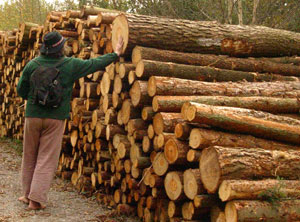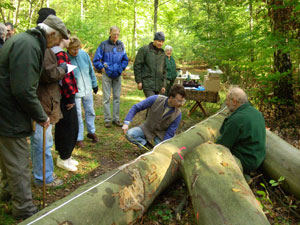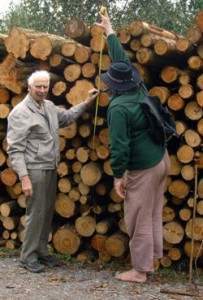How big is ?

We all sometimes wonder how big a tree is. We can guess the height and measure the circumference, but we really need to know more for two reasons:
- we don't want to be ripped off even if we're only selling firewood;
- and the Forestry Commission only allows us to fell trees, without a licence, up to a maximum of 2 cubic metres of wood per 3 month period if the wood is being sold, or 5 cubic metres if it's for our own use *.
Measuring a standing tree The most important dimension is its diameter at 1.3 M up the trunk. This position is known the world over as 'breast height' and the diameter as 'diameter breast height' or DBH for short. Foresters use tapes specially marked off to read diameter when placed around the trunk, but an ordinary tape measure is fine, just remember to divide the circumference (girth) by pi (3.142).
Now although the shape of a tree is wretchedly awkward, the relationship between DBH and volume or weight of wood is a good one. And the size to try and remember is that a tree of 40 cm DBH has, very roughly, one cubic metre or one ton of wet wood in it. One of 20 cm DBH will have about a quarter of this and one of 60 cm about 3 -4 times. It's all on page 83 of Badgers, Beeches and Blisters. What we don't mention in the book is a nice rule of thumb: if you can hug a tree and your fingers just overlap it will be about 40 cm DBH and have about a ton of wood in it! So you can fell two huggable trees every 3 months without needing a licence!!
Measuring a log on the ground
This is easy provided you can get your measuring tape underneath the log at its mid point! Measure the length of the log, determine its mid point, i.e. exactly half way along, and measure its diameter there. Use this diameter to calculate the cross-sectional area (the area of the circle). Multiply cross-sectional area by length and that will give you approximate volume.
Measuring a stack of logs
 Assuming the stack is reasonably tidy, simply measure its length, its average height and multiply these dimensions by the log/billet lengths in the stack. (The logs/billets will normally have been cut to a standard length.) Multiplying these three figures gives us a the solid volume of the stack. To take account of all the gaps or airspace because logs are round, knobbly, bent etc. multiply the solid volume by 0.6 to estimate the approximate amount (volume) of actual wood. This proportion of 60% or 0.6 varies somewhat, but by using it you will get a safe and usually conservative estimate.
Assuming the stack is reasonably tidy, simply measure its length, its average height and multiply these dimensions by the log/billet lengths in the stack. (The logs/billets will normally have been cut to a standard length.) Multiplying these three figures gives us a the solid volume of the stack. To take account of all the gaps or airspace because logs are round, knobbly, bent etc. multiply the solid volume by 0.6 to estimate the approximate amount (volume) of actual wood. This proportion of 60% or 0.6 varies somewhat, but by using it you will get a safe and usually conservative estimate.
* There are one or two other exemptions - see Badgers, Beeches and Blisters pp 44-45.
Comments are closed for this post.
Discussion
Thank you for my first update, excellent reading and I really look forward to ‘my future’ woodland, wherever that ends up being. (I have spoken to Woodlands colleagues recently)
You mention in your opening paragraph that we can roughly guess the height of a tree! You don’t make any mention of an even more accurate of measuring (any one can do this very easily, even my wife so it’s definitely easy, sorry dear)
Take a ‘stick’ size is unimportant, but cut/break it to the length of an outstretched arm. Hold the ‘stick’ vertically in your hand at the halfway point and sight along the stick and walk back/forward until you can see the base of the tree at the bottom of the ‘stick’ whilst at the same time viewing the top of the tree at the top of the ‘stick’ (who says we can’t multi task) The distance you are away from the tree will be the height of the tree. (large paces from this point to the tree will give you metres, 2 paces per metre for kids)It works.

Thank you Julian and Dave. Very useful.
Not quite the same topic but can you possibly help with approximate diameter of oak coppice year by year? I realise it must depend on climate and soil conditions but I just need a rough idea. I am researching stone age woodworking and there is certainly evidence of coppice in the Neolithic. I suspect they may have harvested more frequently than has been normal since the introduction of iron axes.
Thanks
Laurie Elvin
10 November, 2011